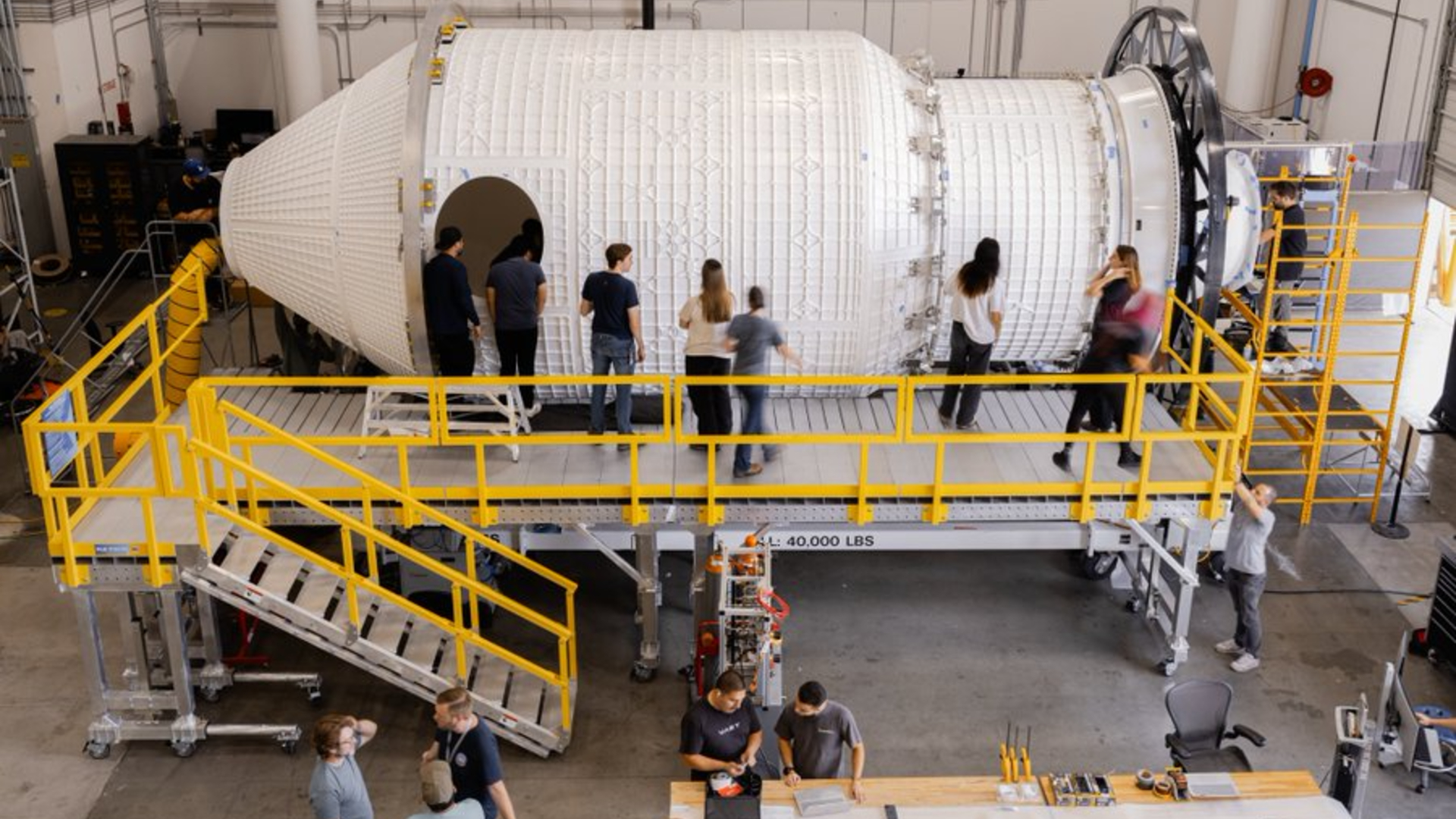Vast gearing up to launch its Haven-1 private space station in 2026
"If we stick to our plan, we will be the first standalone commercial LEO platform ever in space with Haven-1, and that's an amazing inflection point for human spaceflight."

Vast is moving into the final stages of building its Haven-1 private space station, readying for launch in 2026, in a move that could open up a new era in human spaceflight.
In the past couple of weeks, the California-based startup has completed the final weld on the primary structure of Haven-1, followed by painting. Next steps include integrating the flight article's hatch and a domed window as the company moves closer to realizing its vision of a private space station in low Earth orbit (LEO).
Haven-1 is designed to launch on a SpaceX Falcon 9 and, at around 31,000 pounds (14,000 kilograms), will be the largest spacecraft to lift off atop the rocket. The space station is planned to host up to four short-duration astronaut missions during its three-year lifespan, with crews of four people spending 10 days at a time aboard Haven-1 (or some other combination of missions totaling 160 astronaut days).
The space station is intended to be a stepping stone into a new era of human spaceflight, according to Vast lead astronaut Drew Feustel, who spoke with Space.com at the 76th International Astronautical Congress (IAC) in Sydney, Australia, in early October.
"If we stick to our plan, we will be the first standalone commercial LEO platform ever in space with Haven-1, and that's an amazing inflection point for human spaceflight," said Feustel, who's a former NASA astronaut. The Falcon 9 for the launch is booked, and liftoff could take place as soon as the second quarter of 2026.
Vast's rise has been meteoric. Founded in 2021, the company has swelled to around 800 employees. Nearly all of its hardware is built in-house, with only solar arrays and thrusters outsourced. "When I joined in December 2023, we were still deciding between stainless steel and aluminum." Feustel recalled. "Now, less than two years later, the primary structure is welded."
Haven-1 will not just be a private station. It will look to take human spaceflight in a new direction, learning lessons from industry trends and making the human experience more central.
Breaking space news, the latest updates on rocket launches, skywatching events and more!
The Haven-1 flight article has been painted. Next, key components including the hatch and domed window will be integrated ahead of pressure and load testing in Mojave, CA. pic.twitter.com/uGdlK67zyLOctober 11, 2025
The company has been taking some pages out of the book of SpaceX, which has revolutionized access to the final frontier and was the first space company to start building a commercial vehicle that wasn't designed and developed by NASA.
"What SpaceX did — making it clean and functional at the same time — was something astronauts were skeptical of at first," Feustel said. "But we came to appreciate the calmness of the environment."
Vast has also picked up expertise and experience from Elon Musk's company. "A lot of our people are former SpaceX employees who wanted to do it again, but this time with a space station."
Haven-1 contrasts with the utilitarian International Space Station (ISS) and with a more human-centered design. The aesthetics, psychology and "Earth tones" of Haven-1 are designed for comfort and calm. Vast also hired a former Campbell's food developer to rethink astronaut cuisine, and has developed an inflatable sleep system that allows crew members to adjust the pressure to create a sense of simulated gravity for sleeping, rather than the tethered sleeping bag approach on the ISS. Visitors to the Vast exhibit at IAC could try out the new system.
When it launches in 2026, Haven-1 will mark a milestone, but it is also designed as a testbed for bigger plans. Haven-2 is a much more ambitious, modular project that Vast hopes could replace the ISS, which will be deorbited in 2030.
Haven-2's modules will add a second docking port, have a larger volume, fixed solar arrays, and likely a second window. Its modular design allows attachment of cargo or future nodes, including a central node designed to launch via SpaceX's Starship megarocket, which is under development. This larger outpost would be a stepping stone toward artificial gravity and long-term habitation.
"Haven-2 will be stretched in length, add another docking port, and become more modular. We can attach cargo supply while the crew is there," Feustel said. These modules will need to launch on a SpaceX Falcon Heavy rocket with elongated fairings. "The central node can only launch on Starship. It's an eight-meter-diameter class structure."
Haven-1 is privately funded, and its launch is paid for. Haven-2's design depends on NASA's Commercial LEO Destinations (CLD) program, however. "Once we know the expectations, we can head down with full focus — our architecture is flexible enough to adapt," Feustel said.
Again, Haven-2 is a step toward a grander vision. "We were founded for long-term living in space, so artificial gravity," said Eva Behrend, Vast's vice president of communications. "But we realized we needed stepping stones. So we said, 'Let's just build it and prove we can do it.'"
"We think of ourselves as building destinations in space — places for people to live, work and look back at Earth," said Behrend. For now, it's Haven-1 and Haven-2 in low Earth orbit, but Vast has its sights set on destinations beyond.

Andrew is a freelance space journalist with a focus on reporting on China's rapidly growing space sector. He began writing for Space.com in 2019 and writes for SpaceNews, IEEE Spectrum, National Geographic, Sky & Telescope, New Scientist and others. Andrew first caught the space bug when, as a youngster, he saw Voyager images of other worlds in our solar system for the first time. Away from space, Andrew enjoys trail running in the forests of Finland. You can follow him on Twitter @AJ_FI.
You must confirm your public display name before commenting
Please logout and then login again, you will then be prompted to enter your display name.
